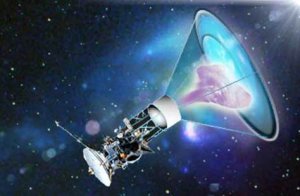

Up until now, the prospect of anti-gravity technology has been strictly confined to science fiction stories and films alike. However, CERN physicists are set to begin an experiment that may well revolutionise our understanding of how the universe works (CERN is the European Organization for Nuclear Research – the acronym comes from the original French spelling). They will be investigating the idea that antimatter may generate a gravitational field that repels that produced by ordinary matter.
What is antimatter? An antiparticle, such as a positron or antiproton, has an identical mass to its ordinary matter counterpart, but possesses an opposite charge—the key properties are reversed. If a regular particle and its antiparticle identity were to physically come into contact with another, the result would be the annihilation of both and the production of gamma rays, neutrinos and lower mass particle pairs. But antiparticles also have the ability to come together in the exact same way that regular particles do to create anti-atoms. Physicists have successfully bound together an antiproton and a positron to create antihydrogen and antihelium.
TECHNICAL ISSUES:

Despite being theoretically possible, to date, we haven’t produced any antiatoms with a higher mass than antihelium, and nor have we observed any such particles in nature. The question as to why we don’t see clumps of antimatter anywhere in the observable universe is a real mystery. One would expect an equal amount of both matter and antimatter, but why we appear to only see regular matter is one of the greatest questions in physics. To clarify, we have detected antiparticles within cosmic rays but these are thought to originate in stars during very high-energy collisions of normal matter.
Antihydrogen was first created in 1995, and currently our means to keep producing it are inefficient and incredibly expensive—it takes $250 million to produce 10 milligrams of positrons. It takes 100 billion years to create enough antiprotons for 1 gram of antihydrogen, and that’s if we produced them at a rate of ten million every minute. And if producing the stuff wasn’t hard enough, keeping it stable and preserved is even harder! It can only be contained using powerful magnetic fields, and the record is 309 antihyrdrogen atoms trapped for 17 minutes–a huge feat.
CERN’s unique ability to produce and trap antimatter has also meant that they haven’t been able to study its gravitational properties, as the magnetic fields are so strong that any gravitational forces that could be acting on the antiatoms are negligible. They are also unable to collect antimatter into a flask, dismissing any factual ground for the author Dan Brown in his book “Angels and Demons”, where a quarter of a gram of antimatter stolen from CERN threatens to unleash the power of 5,000 tons of TNT! Instead, physicists are planning to trap 100 antiatoms in a magnetic field, and then gradually turn it off so that they move freely under gravity alone. The theory predicts that because antihydrogen has the same mass as hydrogen, it should interact with gravity in the same way. So if the antihydrogen “falls” upwards when influenced by the Earth’s gravitational field, we will have to go back to the drawing board to reassess what we think we know about mass and gravity.
IMPORTANCE:
If scientists do discover that anti-gravity, then it may hold a gateway into understanding problems such as why the universe’s expansion is accelerating, why antimatter exists, and why there doesn’t appear to be equal amounts of matter and antimatter. It may be that anti-gravity’s repelling properties of ordinary matter have pushed it outside the observable universe. Practice has shown there is a tiny difference between matter and antimatter, and, as put by Swansea University physicist Niels Madsen, “This tiny difference between matter and antimatter is perhaps physics’ biggest problem and, maybe, we can solve it.”

If such a radical discovery is made, one day we might be able to create containers of the exotic substance to use in an array of technologies. Both aviation in our atmosphere and sending rockets into space require the use of huge volumes of fuel, which isn’t good for the environment. Being able to use antimatter to repel ourselves away from the planet may open new doors for interplanetary and interstellar travel. But such a mechanism in the wrong hands may also bring devastation. The act of simply lifting rocks above the Earth using antigravity technology and then dropping them down on enemies would have the power equal to or greater than that of atomic bombs.
As we take these baby steps deeper and deeper into the fundamental principles that govern our universe, it only highlights the fact that global unification among a common cause for sustainability is vitally important for not just the survival of a country, but our survival as a species.